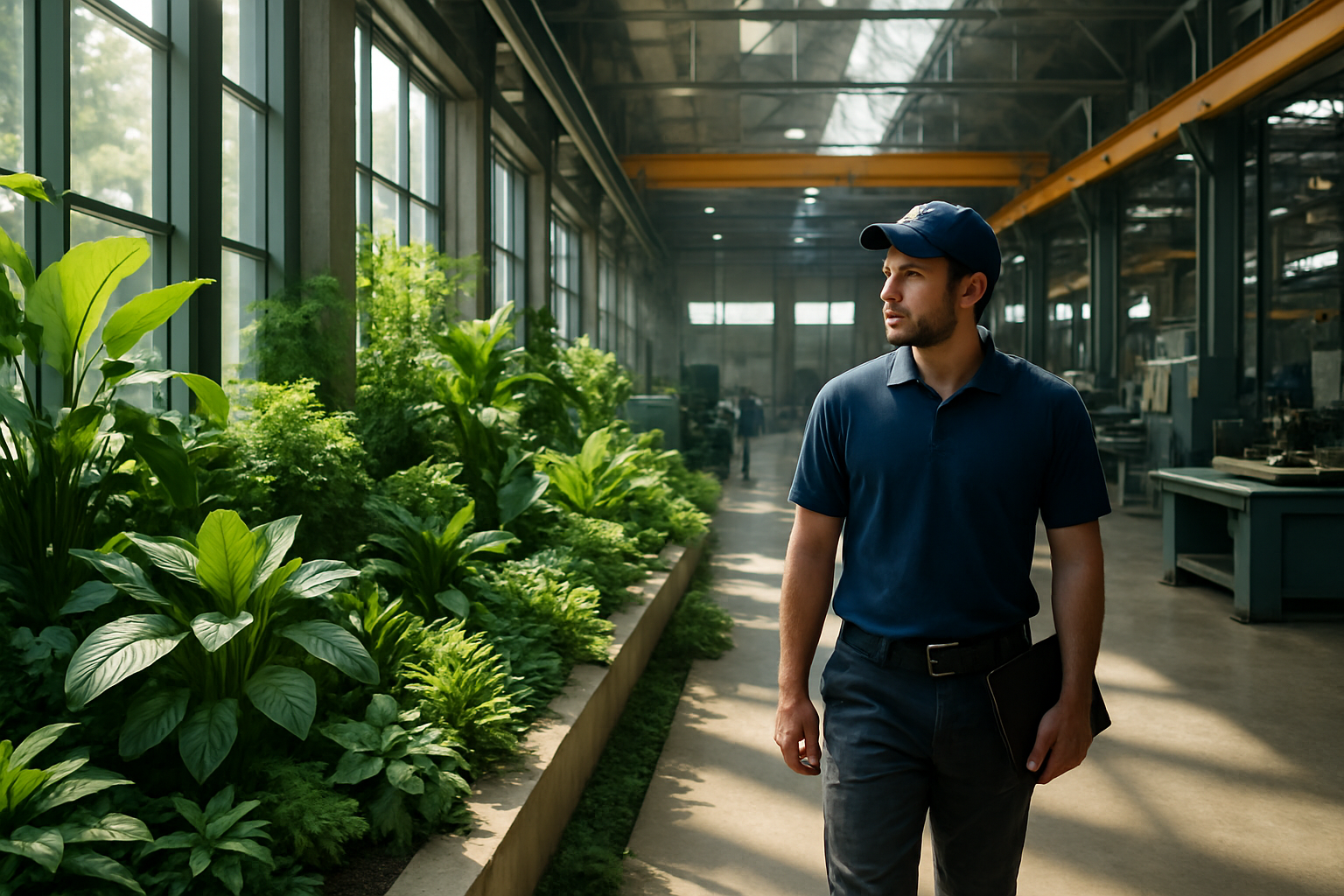Biophilic Design in Industrial Workspaces
Enhancing employee well-being and productivity through nature-inspired environments is revolutionizing industrial workplace design. This innovative approach, known as biophilic design, integrates natural elements into manufacturing facilities, warehouses, and other industrial settings, fostering a connection between workers and the natural world.

The Origins of Biophilic Design
The concept of biophilia, introduced by psychoanalyst Erich Fromm in the 1970s and later popularized by biologist Edward O. Wilson, suggests that humans have an innate tendency to seek connections with nature and other forms of life. This theory laid the foundation for biophilic design, which began gaining traction in architectural and urban planning circles in the 1990s and 2000s.
Initially, biophilic design principles were primarily applied to office spaces, healthcare facilities, and residential buildings. However, the industrial sector, traditionally focused on functionality and efficiency, largely overlooked these concepts. It wasn’t until the late 2010s that forward-thinking companies began to explore the potential benefits of incorporating biophilic elements into industrial settings.
The Science Behind Biophilic Design
Research has consistently shown that exposure to natural elements can have significant positive effects on human health, well-being, and productivity. Studies conducted in various workplace settings have demonstrated that biophilic design can lead to reduced stress levels, improved cognitive function, and increased job satisfaction.
For instance, a study published in the Journal of Experimental Psychology found that the presence of plants in a workspace can increase productivity by up to 15%. Another research project by the World Green Building Council reported that employees working in environments with natural elements, such as daylight and greenery, showed a 101% increase in cognitive scores compared to those in conventional workspaces.
Implementing Biophilic Design in Industrial Settings
Adapting biophilic design principles to industrial environments presents unique challenges and opportunities. Unlike office spaces, industrial facilities often have specific safety requirements, heavy machinery, and stringent cleanliness standards that must be considered when introducing natural elements.
Some key strategies for implementing biophilic design in industrial workspaces include:
-
Maximizing natural light: Incorporating skylights, light wells, and strategically placed windows can significantly increase exposure to daylight, improving mood and alertness.
-
Introducing indoor plants: Carefully selected vegetation can purify air, reduce noise, and create visual interest without interfering with industrial processes.
-
Using natural materials: Incorporating wood, stone, and other organic materials in walls, floors, and furnishings can create a more inviting and less sterile environment.
-
Mimicking natural patterns: Integrating designs inspired by natural forms and patterns into architectural elements and equipment layouts can subconsciously evoke a connection with nature.
-
Creating outdoor spaces: Developing green areas or courtyards within industrial complexes provides employees with opportunities for direct contact with nature during breaks.
Case Studies: Biophilic Design in Action
Several pioneering companies have already embraced biophilic design in their industrial facilities, demonstrating its potential to transform traditionally austere environments into more human-centric spaces.
One notable example is a large automotive manufacturing plant in Germany that incorporated a “green wall” of living plants into its assembly line area. This vertical garden not only improved air quality but also served as a natural sound barrier, reducing noise pollution in the facility. Employees reported feeling more relaxed and focused, leading to a measurable decrease in errors and an increase in overall productivity.
Another case study involves a distribution center in the United States that redesigned its workspace to maximize natural light and views of the surrounding landscape. By installing large windows and skylights, the company was able to reduce its reliance on artificial lighting, resulting in significant energy savings. Additionally, employees reported higher job satisfaction and fewer sick days, attributing these improvements to the more pleasant work environment.
Challenges and Considerations
While the benefits of biophilic design in industrial settings are compelling, there are several challenges that companies must address when implementing these principles:
-
Cost: Initial investments in redesigning existing facilities or incorporating biophilic elements into new constructions can be substantial.
-
Maintenance: Living elements such as plants and green walls require ongoing care and attention to remain healthy and effective.
-
Safety: Ensuring that natural elements do not interfere with industrial processes or create hazards for workers is paramount.
-
Regulatory compliance: Some industries have strict regulations regarding cleanliness and contamination control, which may limit the types of natural elements that can be introduced.
-
Employee education: Workers may need to be educated about the benefits of biophilic design to fully appreciate and engage with the new environment.
The Future of Biophilic Industrial Design
As awareness of the benefits of biophilic design grows and more case studies demonstrate its positive impact on industrial operations, it is likely that we will see wider adoption of these principles in manufacturing, logistics, and other industrial sectors.
Emerging technologies such as smart lighting systems that mimic natural light cycles and advanced air purification systems that incorporate living plants are already pushing the boundaries of what’s possible in biophilic industrial design. As these technologies continue to evolve, they will offer even more opportunities for creating nature-inspired workspaces that enhance both human well-being and operational efficiency.
Key Insights for Implementing Biophilic Design in Industrial Spaces
• Start small: Begin with pilot projects in specific areas of your facility to test the impact and gather data on employee responses.
• Involve employees: Engage workers in the design process to ensure that changes meet their needs and preferences.
• Customize solutions: Tailor biophilic elements to your specific industry and operational requirements.
• Monitor and measure: Implement systems to track changes in productivity, employee satisfaction, and other relevant metrics.
• Integrate with existing systems: Look for ways to incorporate biophilic design into existing infrastructure and processes to minimize disruption.
The integration of biophilic design into industrial workspaces represents a significant shift in how we approach the built environment in manufacturing and logistics. By recognizing the fundamental human need for connection with nature and incorporating it into traditionally utilitarian spaces, companies can create more humane, sustainable, and productive industrial environments. As research continues to demonstrate the tangible benefits of this approach, biophilic design is poised to become an essential consideration in industrial facility planning and management, potentially reshaping the future of work in these sectors.





